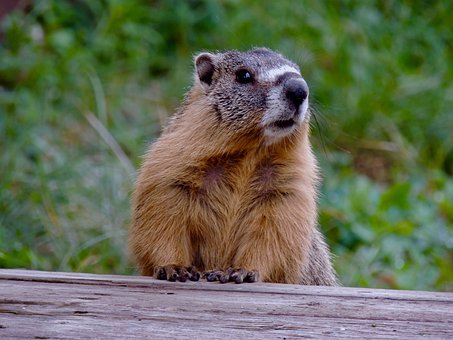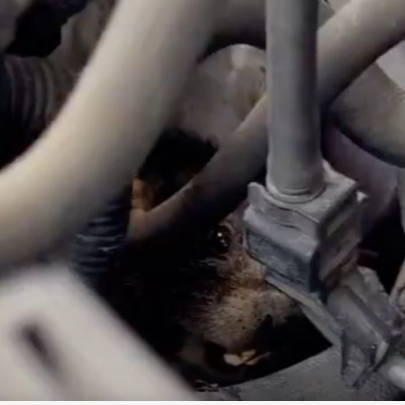
Your car is your beloved companion. It adds little joy to your life by taking you from place to place. But did you know your car could be haunted by those pesky yellow-bellied rodents?
These creatures might snuggle under your car’s hood!
During the winter and spring months, when it’s cold outside they hibernate. They can freeze or starve if they don’t store enough fat so, a car is the perfect nesting place for them. Car engines are normally warm, dry, and undisturbed, making them a perfect place to eat, rest, or breed. And once they get inside, they will cause serious damage to the vehicle, the damage that may end up causing holes in your pocket. So you surely don’t want these creepy critters.
Marmots are large ground herbivorous squirrels, which includes 15 species and found in Asia, Europe, and North America. They are large rodents with short legs and enlarged claws adapted for digging. Despite being known to cause damage to gardens and crops they can be a serious threat to cars!
Your car would be eaten by marmots. Not the whole vehicle, just your radiator hoses, brake lines, and hood insulation. They prefer radiator hoses to search for an alternative for ethylene glycol which is found in anti-freeze liquid. Antifreeze has a naturally sweet taste and fragrance that pull marmot’s attention in.
The tasty rubber and plastic bits of your engine are attracting attention among marmots, but most marmot species have a voracious hunger for the most delicate car parts.
Here is the evidence of the same.
Marmot Rescued from the engine compartment of a car
Springville | March 26, 2020
When a Utah woman noticed something wrong with her car last week, she took it into a maintenance shop to see what the problem was. It turned out a large rodent was stowed away inside the engine compartment of her vehicle.
The woman brought her car to a Jiffy Lube in Springville on Saturday after noticing debris and some oil on the ground near her car. Mechanics opened up the hood and said there appeared to be a marmot stuck inside, according to Utah Division of Wildlife Resources conservation officer Sean Spencer.

After making some calls, Spencer was dispatched to help. The rescue was caught on camera and it shows the creature peering from underneath the vehicle’s engine hoses.
Along with this, a marmot pup causes the damage of more than $1,000 by climbing around in someone’s car in Crested Butte. Also, according to Harold Werner, Biologist, U.S. Fish, and Wildlife Service,
“Some 200 marmots do this every year, damaging 20 to 40 cars in Mineral King Valley”
These critters wreak havoc every year in the Mineral King area in California. It seems like marmots wait for cars to show up near that area!
These creepy critters may look cute but they can also carry diseases like plague and fleas can come in contact with humans and pets which are spread by marmots. Their droppings carry parasites and bacteria which may cause diarrhea and nausea.
Though marmots are the most well-known engine wreakers, they also transform grassland landscapes, providing habitats for many other species. They have often been considered ecosystem’s engineers!
So, it is important to keep marmots away from our vehicles but also keep in mind that they are not harmed or destroyed by us.
Not only marmots but other rodents like rats and squirrels are especially fond of gnawing on engine wires. Short circuits can occur if rodents chew away at the insulation covering the wires, resulting in costly engine damage. And the insulation on your new wires can simply be chewed away when you fix the wires!
Your car engine could be a desirable nest for rodents. They can use the engine’s insulating fabrics nesting material. There are several dark corners in the engine that could serve as safe havens for baby rodents.
Below is the news reported a few weeks ago.
‘Dublin couple may have to fork out thousands after rats chew through car’
A Dublin couple fears they will have to fork out thousands to repair their car after it was destroyed by rats at a city center flat complex.
The couple’s 2017 car had only just passed its NCT when it was destroyed by the rodents, who chewed through the electronics, sending the motor haywire at the Vincent Street Flats in Dublin.
The woman told Dublin Live: “We were out in the car on weekend and everything was grand.
“We didn’t go out on weekend but when we went out, my husband turned on the engine, and all the engine management lights all started flashing and beeping and saying the tyres were down and other things were wrong.
“He got out and checked the tyres and they were all fine but then when he was parking he realized the parking sensor wasn’t working either.”
The worried couple took the car to their mechanic who immediately spotted that the damage had been done by rats that have been plaguing the area for several years.
The couple is now waiting anxiously to find out how much it is going to cost to carry out the extensive repairs.
So, what can be the effective steps taken to keep them away from the cars without destroying them?
Now, the world is becoming environment conscious day by day so we at C Tech Corporation developed environment-friendly, non-hazardous, non-toxic, non-mutagenic, and non-carcinogenic product range to fight the problem without killing the pests.
Our product, Rodrepel™, is anti-rodent and animal aversive that works on the principle of repellence. Its mechanism works on 6 prolonged strategies which not only effective against marmots but will keep away other rodents like squirrels, rats, beavers, and gophers.
Rodrepel™ is available in the form of a masterbatch, liquid concentrate, lacquer, and sprays.
The masterbatch can be incorporated with the polymer to manufacture cable sheathing and interior polymeric parts.
The liquid concentrate can be mixed with paints and used to coat cars and lacquer can be used as a topical application for existing wires, radiator hoses, and inside of the car.
The ready-to-use Rodrepel™ spray is easy to use and protects cars from rodent damage. It can be easily sprayed on any car parts.
The product is compliant with RoHS, RoHS2, RoHS3, REACH, APVMA, NEA, EU-BPR, and FIFRA exempted.
Contact us at technical.marketing@ctechcorporation.com to keep the rodents away.
Also, visit our websites:
1] http://www.ctechcorporation.com/
2] http://www.rodrepel.com/
3] http://www.termirepel.com/
4] http://www.combirepel.com/
Follow our Facebook pages at:
1] https://www.facebook.com/Combirepel-411710912249274/
2] https://www.facebook.com/Termirepel-104225413091251/
3] https://www.facebook.com/Rodrepel-120734974768048/
Follow us on our Twitter pages at:
1] https://twitter.com/rodrepel
2] https://twitter.com/termirepel
3] https://twitter.com/combirepel
